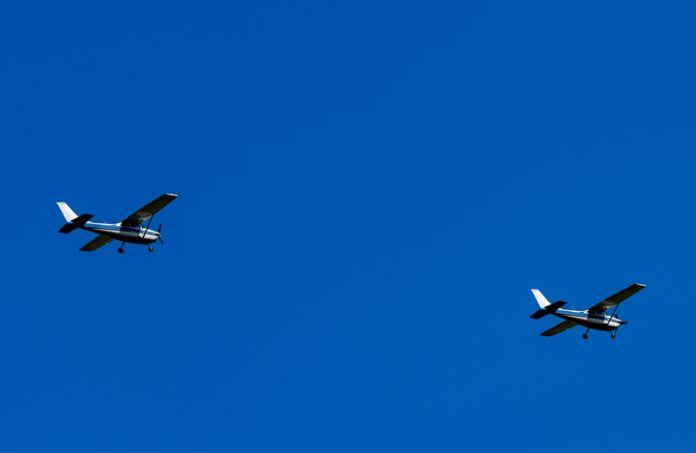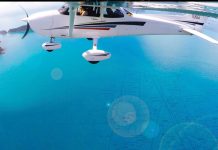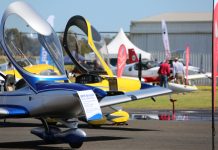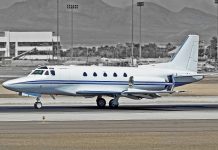Seeing is believing, or so the saying goes. But is it enough to just see?
Your VFR flight is in class G airspace. It’s likely that there’s other traffic out there, and you have a responsibility to see and avoid it. But just how do you do that?
If you’re using ‘unalerted’ see and avoid—relying on just peering out of the window and looking for other traffic—you need quite a few things going for you.
As Civil Aviation Advisory Publication (CAAP) 166-2 points out, size and contrast are the two primary factors that determine the likelihood of detecting other aircraft, size being the more important. It shouldn’t be too difficult to see hot air balloons, but as general aviation, sport and recreational aircraft and rotorcraft are usually small or have low visual profiles, it may be very difficult to see them.
We can and should scan for other traffic, but if there is nothing specific to focus on, our eyes revert to a relaxed intermediate focal distance, which means you can end up looking without actually seeing anything. The eye defaults to a resting state and the lens focuses approximately one to two metres away, so distant objects such as conflicting traffic appear smaller and further away than they really are.
In a 1991 research report commissioned after a fatal collision between a Cessna 172 and a Piper Tomahawk in the downwind leg of the circuit at Coolangatta in 1988, the Australian Transport Safety Bureau (ATSB) said that the see-and-avoid concept had limitations such as those of the human visual system, windscreen configurations and competing demands for pilots’ attention.
Factors which can adversely affect vision and lookout include the amount of ambient light, window posts and the cleanliness and crazing of windscreens, particularly when flying towards the sun. And of course, we’re humans not machines, so we can be distracted by personal concerns, passengers or cockpit workload.
The ATSB research report concluded that ‘cockpit workload and other factors reduce the time that pilots spend in traffic scans. Even when pilots are looking out there is no guarantee that other aircraft will be sighted.’
Effective scanning
To effectively scan for conflicting traffic, use short, regularly-spaced eye movements that bring successive areas of the sky into your central visual field.
Each movement should not exceed 10 degrees, and each area should be observed for at least one second. Develop a pattern that works for you and stick to it. You may need to move your head to see beyond window posts and any other obstructions, such as pilots or passengers in the adjacent seat/s.
If you do the maths, a complete 180 degree horizontal and 30 degree vertical scan using this method could take at least 54 seconds. US military research found that it takes a pilot 12.5 seconds to avoid a collision after target detection. There can therefore be considerable time gaps in which traffic is not detected during a normal scan period.
Alerted see and avoid
The research shows that the effectiveness of a search for other traffic is some eight times greater when you’re alerted than when you’re unalerted. So, it really helps to have some idea of where to look and what you’re looking for.
Maintaining a good lookout is important, but so is using your radio to talk and listen to other traffic, paying careful attention to NOTAMS as part of your flight planning, and avoiding areas of high activity, such as parachuting or gliding.
If you are in or approaching a CTAF, make sure you broadcast your position, listen out and acknowledge. It’s a good idea to monitor the area frequency as well. Remember you can ask for help from ATC on the area frequency. Don’t be afraid to ask your passengers to help with your lookout, too.
It’s a question of balance. If you hear a radio call but can’t see the other aircraft, maintain your lookout but don’t spend too much time on trying to locate the other aircraft. Remember that the other aircraft may have incorrectly reported its location and intentions.
Don’t rely on so-called ‘live’ traffic on electronic flight bags software such as Avplan and OzRunways, as it is delayed, incomplete and relies on your device having a 4G data connection. ADS-B In (if fitted) may also help—but it’s only part of the picture.
Understanding human limitations
The midair crash which killed four people at Coolangatta nearly 30 years ago happened in controlled airspace. Controller workload was a factor, so the accident cannot be explained simply as a breakdown of ‘see and avoid’ by the pilots concerned.
But a similar situation—where two aircraft lose sight of each other in a busy circuit—could easily occur in a CTAF.
The then Bureau of Aviation Safety Investigation’s report said, ‘The pilots … appeared to have lost an awareness of the relative positions of each aircraft. Monitoring of the various radio transmissions could have alerted them to the fact that the separation between them was decreasing, and it would be expected that their level of visual surveillance would be raised. There was no evidence that any avoiding action was taken by either aircraft.’
A human factors specialist quoted in the report said, ‘Unless human operators such as pilots and controllers are made fully aware of the nature and consequences of the … basic limitation on their performance capabilities through appropriate training and awareness programs, they tend to assume that they can cope with high workload situations simply by “trying harder”. It has sometimes proved to be a fatal assumption.’
Further reading
Australian Transport Safety Bureau, 1991: Limitation of the See-and-Avoid Principle






These articles make for a quick jog of the memory as far as rules & regs go but in reality it’s a very diff world out there. The risks of two aircraft colliding these days is getting less & less due CASA, their mantra ” Safe skies are M/T skies” is working well!!!
“See and Avoid” is ‘the’ most fundamental concept behind the safe air transport system; why do we have the ATC system we have, one which tends to ‘lump’ traffic together on regulated routes etc. and which increases the system risk over a ‘randomised’ traffic conflict pattern? If the system is going to rely on the ‘big sky theory’ to any extent and newer technologies like TCAS/ ADSB etc. to a greater extent, then system designers need to quickly work out where they want the ‘authority’ to reside; with a personnel based system on the ground, or one in the air or perhaps where technology is in 100% control? The correct answer will save the industry much money and allow for the better resourcing of smaller operations. No-one can afford an incorrect answer.
Here’s what we’re up against .. from the 3min 10sec mark .. but don’t blink! https://www.youtube.com/watch?v=TgnUpnRlaIw
[…] Safety Australia looked at the limitations of see-and-avoid techniques last year in Unalerted see and avoid it’s not a good look and Be seen and be […]